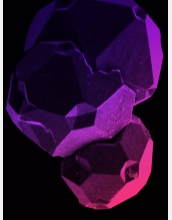Multimedia Gallery
Grains of boron suboxide
These grains of boron suboxide, which are submicroscopic, loom like boulders in this scanning electron microscope view. The grains are tough--only diamond and cubic boron nitride are harder--and exhibit a rare, five-fold symmetry. Boron and oxygen atoms form 20-sided icosahedra that pack together into the larger crystalline icosahedra seen here. The research was performed at Arizona State University's (ASU) Materials Research Science and Engineering Center (MRSEC), which was supported by the National Science Foundation at the time the research was performed.
More about this image
ASU posdoctoral researcher Herve Hubert synthesized the material by mixing boron and boron oxide and heating them at high pressure--up to 1,700 degrees Celsius--and at 40,000 times the atmospheric pressure at sea level. Tiny orange-red particles form during the heating and pressurization that have a perfect icosahedral shape--each particle, with 20 triangular faces and 12 corners, displays five-fold symmetry. A crystal, which contains atoms packed in a regular repeating pattern, cannot have five-fold symmetry.
Icosahedral particles in nature are rare. Some viruses pack in this way, but they are much smaller in size. Twenty tetrahedra--a solid with four faces, each a perfect crystal--come together at a point to form a radiating pattern away from the center. This substance displays a new way of packing atoms together to make a solid.
This boron suboxide material ranks as the third-hardest substance in the world. It appears to have promising industrial potential. Since boron suboxide is extremely hard, it can be used as an abrasive or as a cutting or polishing tool and its mechanical characteristics and low chemical reactivity make it a candidate to replace tungsten carbide in high-wear applications. Boran suboxide may possess special semiconductor applications as well. (Year of Image: 1999)
Credit: Laurence Garvie, Ph.D.
Special Restrictions: The owner has restricted the use of this image. Permission is granted to use the image for personal, educational or nonprofit/non-commercial purposes only, and only after sending an email notifying your intent to use to Laurence Garvie, lgarvie@asu.edu. Permission to use this image in any other manner is prohibited without prior permission from the owner.
Images and other media in the National Science Foundation Multimedia Gallery are available for use in print and electronic material by NSF employees, members of the media, university staff, teachers and the general public. All media in the gallery are intended for personal, educational and nonprofit/non-commercial use only.
Images credited to the National Science Foundation, a federal agency, are in the public domain. The images were created by employees of the United States Government as part of their official duties or prepared by contractors as "works for hire" for NSF. You may freely use NSF-credited images and, at your discretion, credit NSF with a "Courtesy: National Science Foundation" notation.
Additional information about general usage can be found in Conditions.
Also Available:
Download the high-resolution TIFF version of the image. (7.8 MB)
Use your mouse to right-click (Mac users may need to Ctrl-click) the link above and choose the option that will save the file or target to your computer.

